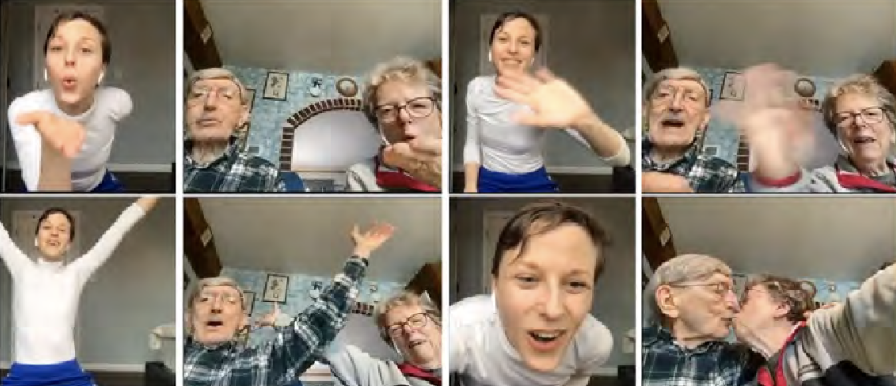
All screenshots captured by Magda Kaczmarska
[ID: Eight images show Magda, a person with short brown hair in a white turtleneck and blue track pants and Bob and Barb, two people with short grey hair and glasses. They are dancing the Hello Body Dance.]
“That which cannot be spoken can be sung. That which cannot be sung can be danced.” — Old French saying
On a Thursday afternoon, a group of 17 people log into a Zoom room from across the United States. As the windows burst onto the screen, we begin to fill the space with hellos and welcomes.
“Shalom aleichem.”
“Shalom” – others repeat and wave back.
(Shalom aleichem is a spoken greeting in Hebrew, meaning “peace be upon you”.)
“Hello! Shalom Shalom, pretty soon you’ll be home.”
Barb wiggles her fingers. Her husband, Bob, sitting next to her adds his wiggling breath. Together, our fingertips and breaths ripple through the crowd.
“Bubble off” says Marv, waving his arms open and closed, making a bubble with his hands.
“Bubble off” we all repeat.
“Oh, it’s a double bubble!” “A double bubble!”
Another day, Marv introduced the “hello-copter” – a swirl of air with one arm, whirring over our heads, beckoning in a “come hither” action as we say hello – at once a hello and a welcome.
We are gathering for a program called Stories in the Moment.
Stories in the Moment is a co-creative dance, movement, and storytelling program for and with people living with dementia. Almost everyone in the room, except for myself and 1 or 2 care partners, are living with dementia. I created Stories in the Moment out of a desire to extend the resource of dance as a tool for expression to communities of people living with dementia and to ally with them to support their creative voice.
I identify as a dance artist with a background in science. Due to my science background and interests, I acknowledge and am very aware of the potential therapeutic effects of the programs I facilitate for communities. But therapy is not the main point of my work. It’s about amplifying other ways of knowing, listening, and speaking. Through Stories in the Moment, we speak not just with our words, but with our sounds, with our body positions, and with our movements. Stories in the Moment is inherently shaped by the people in the space – same as we co-create each of our stories together, the program has been co-created as a community.
Creative community in response to COVID-19
The space we are gathering in today to join in Stories in the Moment, is an online space created through the Dementia Action Alliance’s Virtual Engagement program. The Dementia Action Alliance (DAA) is a non-profit organization that has been supporting and amplifying the voice of people living with dementia in the United States for 25 years. Among other actions, DAA offers peer mentorship for people newly diagnosed with dementia, support groups for people living with dementia led by people living with dementia, podcasts, resources, and an annual conference.
During the COVID-19 pandemic, DAA mobilized to create a virtual engagement platform to offer access every weekday to social, creative, and spiritual engagement and connection for people living with dementia all across the US. Barb and Bob, who have been joining Stories in the Moment regularly share, “We found you and wow, what a difference you have made. What a difference each of the people in DAA have made for us. I just can’t say it enough, it has opened up our world again.”
Participants in Stories in the Moment comment on how much has shifted for them during the pandemic and how its impact continues to influence how they engage and interact with the world around them. “I honestly don’t think I could have survived the pandemic without the online programming. Marv isn’t willing to travel anymore. It’s sad as it’s a big change for us but he is fearful, and, frankly, getting him places is not easy. I sincerely feel that continuing online programming is essential for both partners,” shares Sheila, wife and care partner to Marv, a participant in Stories in the Moment.
For many people living with dementia, the COVID-19 pandemic is still very much active and impacting their lives. Barb comments on her husband, Bob, who is now nine years into his journey with Alzheimer’s: “He’s been very weak, compared to before. Before November, we did two mile walks every day. And now it’s hard for him to get from the living room to the kitchen. He has some days when he kind of just sits at the kitchen table and isn’t doing much of anything. And I’ll put on some music, but he’ll just kind of sit there. And then it’ll be time for our DAA zoom. And he brightens up and he’ll smile. And when you’re doing Stories in the Moment, he’s doing his arm things and everything is so amazing. And so yes, you have been a big help in that.” She goes on to say, “DAA … through the zooms and through the community and getting to know other people, have helped me keep [Bob] here at home where he does have the love and the affection and the freedom to do some activities when he wants to do them.”
Over two years later, DAA’s online engagements are still going strong. Stories in the Moment is one of those programs.
Stories in the Moment is grounded on the understanding that dance is a universal language. We all have stories to tell, and we all have the means to tell our stories. Stories in the Moment taps into the library of stories we have in our bodies that we have accumulated over a lifetime and invites us to share this movement choreography with one another. We discover, expand upon, connect and build these dance stories together, in the moment, inspired by who is in the room.
“In the moment” is a key factor. Dance is an ephemeral art form. Dementia also navigates the ephemeral. When we focus on one another in the moment and create opportunities to connect and create together, we amplify and celebrate the voices, bodies, and minds of each person who is there. And although the stories we create are not being recorded in a material way, they continue to exist in the energy and feeling of community that persists from class to class, from week to week, month to month. These individuals are a community. “I consider them our dear friends. I mean, you’re a part of our lives, and so are so many people from DAA. You’re family almost to us now.” – Barb and Bob
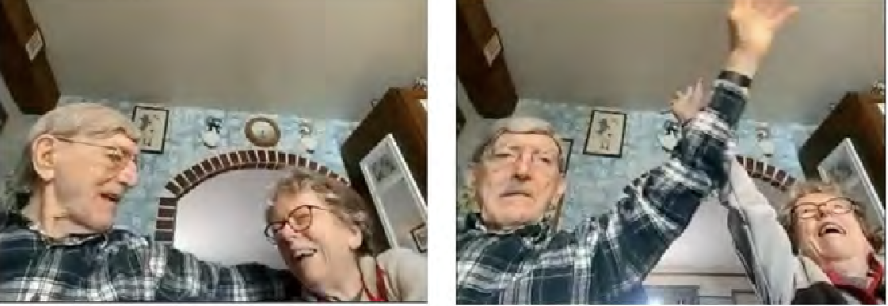
Shared rituals facilitate grounding and belonging
We begin each Stories in the Moment class with our ritual Hello Body Dance, by saying hello and welcoming one another into this shared virtual space. By engaging in this way, we are setting the container for our practice. Each time we repeat this practice, we anchor ourselves into a shared space of belonging and we build, moment by moment, movement by movement, the foundation of our community.
Grounded in the individuals, in stories, in movement and in voice, all modes of communication and connection are welcome and celebrated. They inspire, give permission to and invoke the voices and expression of others. Together we weave a tapestry of connection, appreciation, and love.
“This is supposed to be for love. You should love your bluv. Love your bluv. That’s it!” – Marv
Jan Bays, DAA Board Chair and Director of Program Development and Education at Jill’s House Assisted Living & Memory Care in Bloomington, Indiana reflects on this ritual which grounds the group together in our shared community and opens the space for co-creation. “This is something that is very important. People feel that it is something they expect and look forward to. It makes them feel safe.”
Participants from Jill’s House have been joining Stories in the Moment from its inception. Whereas many other participants join from their individual homes, Jill’s House participants join from their community room as a group. Jan reflects on how despite the difficulty of joining a program on zoom, where I, as the facilitator, am on a large screen along with half a dozen other participants joining from their individual homes, “you notice how well everyone is participating.”
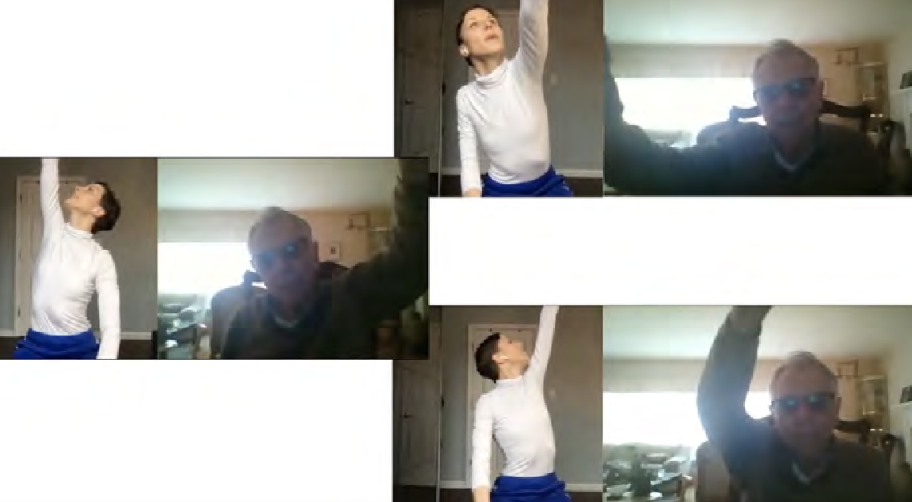
The key behind Stories in the Moment is the community and the relationality. Rather than being delivered at or to participants, every session of Stories in the Moment exists because of the participants. We do everything with one another. Jan reflects on this: “I love the way you can get people to move. However, I think it is the personalization that makes the experience extra special. I see them light up when you speak to them individually.”
“You relate to each single person in the group, even the people at Jill’s house, you relate to each of those individuals. I can barely even see them. But you find a way to let them know that you are connecting with them”, reflects Barb. “It’s not like we’re just a whole group of people and you’re just staring at a whole group. You talk to us individually. And we’re able to comment back and do things in relationship to what you’re saying and doing. And it’s just been heavenly.”
Each individual deserves to be seen, heard and supported in joining a shared space. Living with a chronic disease like dementia, one that is fraught with stigma and misunderstanding, results in people feeling as if they are becoming invisible. People begin to speak on their behalf and their contributions are written off. But people living with dementia have a desire to contribute, to have purpose, and deserve to recognize that their contributions are meaningful.
Environments are invigorated by the people and actions that take place within them. We have to work together to reinforce and support the diverse ways we communicate and expand our tools of listening and speaking. Stories in the Moment seeks to expand and amplify these tools.
Dance belongs to everyone, but it begins with you
I have been allying with diverse communities to facilitate experiences of dance and movement for 18 years, with over 10 years specifically with communities of older adults and people living with chronic conditions like Parkinson’s Disease and dementia. My practice is grounded in the concept of creative aging, the idea that “the golden age” of life is a time of rich experience and celebration of life, rather than a time of restriction and retreat.
Creative aging in itself is a radical act which counters ageism and ableism. It invites us to recognize the beauty in all types of bodies and amplify our experiences and voices over our life course through creative expression. Dance and storytelling helps us develop those tools and encourage spaces where the voices they empower, thrive. I see dance as a practice that doesn’t just take place on stages by “trained professionals” but in our homes and our communities. A practice that is accessible – to all bodies, all ages, all abilities. A practice everybody contributes to, participates in, and receives something from.
Thanks to persistent leaders, many of whom have been my mentors either in person or by inspiration, this view of dance is becoming more widely embraced. More of us recognize that dance is something that is inherent in all of us. And it is something that belongs to us, that we have agency in. Famous American choreographer, Alvin Ailey, stated that, “I believe dance came from the people and that it should always be delivered back to the people.” I believe dance and movement expression is our human right. It belongs to everyone. We deserve opportunities to explore and discover our own movement voices in places where we are seen, valued, where we feel we belong.
After we greet each other, in Stories in the Moment, we take some time to turn our attention to our individual bodies through a gradual tuning in and progressive warm up. Self-agency and trust are key underlying principles of a co-creative practice, but it takes time to listen to our bodies, especially as most of us don’t often get enough time to do so. As a result, hearing and feeling our bodies takes more time. So, we begin by slowing down, meditatively, taking time to check into how our bodies are today before we extend our focus to one another and the group. If we wish to extend a kinesthetic awareness to others, we must first receive space to find that connection within ourselves. This allows for kinesthetic awareness, the sentient and tacit forms of our knowledge and expression, our movement awareness, to take hold and take space.
After taking time to tune in and warm up, we begin to extend our focus from individual kinesthetic approaches to a sense of a group body through a dance called Signature Moves. This approach is founded on the idea that if we trust our bodies, they naturally respond to music with movement.
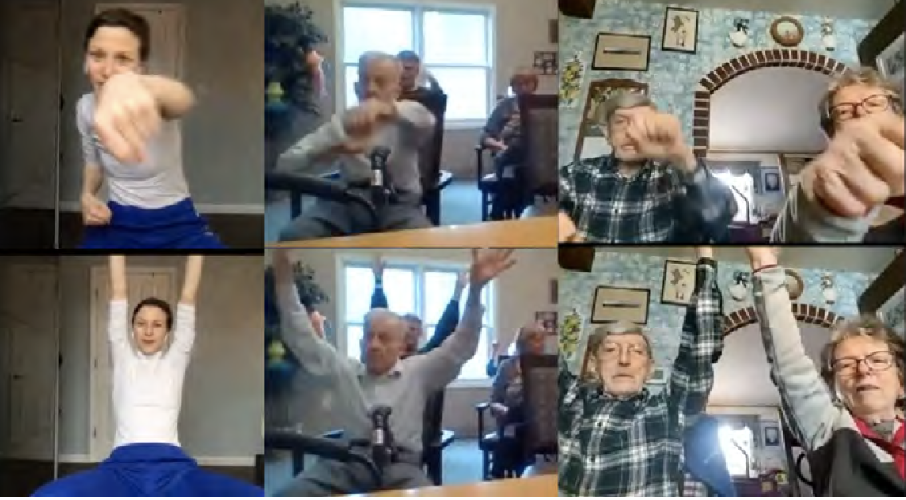
We all have our “signature move” when music that we enjoy comes on. Some of us bob, some of us snap, some of us clap, some of us push back or lean away but still join in the dance and tap our toes, and some of us jump straight into the disco. Signature Moves invites us to just get moving and take turns to share our movement with one another. This is pivotal for all of us, but especially for people living with dementia. This simple act of Signature Moves begins to create a space where they are the experts, and their voices are the center of attention.
“[Bob] has lost so much control over his life. And I hate that for him. And so when we do dancing in the kitchen, we’ll do movements like you do with us. And he’ll start a movement and I will follow his movement. And so he’s in charge. And then he’ll have this big smile on his face. Because, you know, he came up with the movement, and I’m doing the movement with him.”
Creating our own movement and sharing it with one another adds a safe challenge which also sets the stage for the approach we use in our co-creative storytelling, where each individual’s voice is seen, heard, and felt in movement. Together, we assemble them to make our own dance stories.
Dance supports an egalitarian space nourishing dignity and value
Meaningful connection is paramount for maintaining dignity. But too often for people living with dementia, access to this basic human right is characterized by a profound paucity. Relationality is key to meaningful citizenship and people living with dementia are not exempt from the right to it nor are they immune to its benefits.
For the 50 million people living with dementia globally, this lack of meaningful connection is compounded by the detrimental effects of a progressive disease which can impact affective states, mobility and spatial relationships, and ability to communicate or follow conversations. As a result, people living with dementia inevitably experience shifts in their modes of and capacities for expression, which influence their ability to express and feel connected to the communities around them. Reportedly, persons living with dementia and their care partners often experience a reduction in size of their social networks and loss of connection with others as the disease progresses.
A core practice behind Stories in the Moment is the idea of interdependence. We all have a responsibility to care for one another. And that care, support, and expression can look different in various spaces. This is the power of co-creative practice. It amplifies our humanity and opens up opportunities for each of us to enter in and see how our contribution has meaning.
As public health and ethics researcher Pia Kontos writes: “In the context of cognitive impairment, dance takes on even greater significance given that corporeality becomes the primary means of engaging with the world and with others. Dance provides a unique medium for non-verbal communication, affect and reciprocal engagement which profoundly enables the relational citizenship of persons living with dementia.”1
This underlines the demand for programs that engage with people living with dementia as opposed to only delivering programs at or to them. As highlighted by Dr. Gill Livingston in the pivotal 2017 Lancet Commission article, “Engaging in meaningful and pleasurable activities is hypothesized to improve health and wellbeing”. The benefits of these social engagements include “reconnecting individuals to their physical and social environment, supporting self-esteem, building neural connections through complex interactions and promoting a sense of role continuity, purpose, or personhood, self-identity, and meaning.”2
This perspective has powerful ramifications for the challenges we face as a society around how we view people living with dementia and aging in the United States. We are in desperate need of rewriting social narratives to person-centered systems, which view people not through the metric of what they can produce, but who there are, uniquely and holistically. If we shift the way we attribute value to actions and to individuals, we can go a long way to extending the collective feelings of belonging and community. Through Stories in the Moment, I am inviting us to see value in the voices of these individuals and communities who are experts in their lived experience.
A care partner and wife of one of the Stories in the Moment participants reflects on this, “What you do and your attitude and acceptance is invaluable. Most of the participants are extremely well educated and many held important positions. Sadly, they feel their losses every bit as much as their partners do. Since they can still think they can still appreciate the arts, music, dance, paintings and sculpture….the arts enrich their days, dementia or not.” In our conversations, she shares how joining in Stories in the Moment, her husband, Marv, feels engaged and that his unique voice matters. “He adores you. He loves to make jokes, even though some of them miss the mark. And he feels valued, which is super important to him.” In fact, Marv’s participation and jokes, often in the forms of brilliant puns or poems, contribute to the atmosphere of each class, mirroring and amplifying the themes we explore. They highlight how one individual’s words join with another’s movements or sounds to collectively create a multi-sensory dance story, which would be merely two dimensional with one voice.
A theme and variation – group improvisation and co-creation of a dance story
Each class of Stories in the Moment is centered around a theme that guides our creative explorations and drives our collective storytelling. Recently, one of our themes was Sports.
“We can be par-ticular” (Marv on the theme of sports.)
We begin this exploration by seeding ideas inspired by some form of multimedia. Sometimes these are videos compiled around movements and ideas that can guide our exploration. Other times, these seeds are inspired by images that invite deeper conversation in movement, sound and words.
Inspired by these media, we explore these ideas in more depth. During our exploration of Sports, I began by guiding us in a discussion of three sports that use a ball: baseball, bowling and basketball.
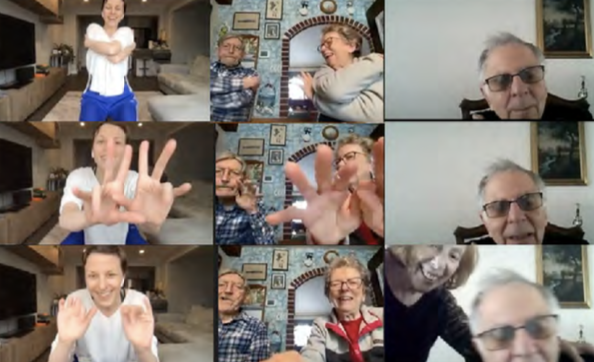
Together we explored the movements we make when we play baseball – setting up to bat, hitting the ball, winding up and releasing the ball during a pitch, diving to catch the ball. Then we explored the movement language of basketball – dribbling the ball, aiming and shooting the ball in the basket.
Phil, one of the participants at Jill’s House, offered to share the proper form and process of bowling – how to hold the ball, set up and release the ball which either rolls to strike the pins down or rolls into the gutter. “And then you sit down in disappointment.”
All of these movements connect to make our first dance story.
Oftentimes, other stories will appear during this discussion. We learn that one participant grew up less than a mile away from Yankee Stadium. Another participant was a pitcher in his youth. And another participant played baseball in her front yard with all the neighborhood kids when she was a child in Tucson, Arizona.
Our exploration of Sports at the Queens Community House in Forest Hills brought in some unexpected ideas. Our dance story included every imaginable tennis swing – the “high throw and swing”, the “side to side”, the gentle “bounce” and the “SLAM!”; a refreshing dive into the swimming pool– or a lake – “I prefer fresh water,” one participant stated – with free-style and breast and back strokes; and finished with a surprising foray into fencing, where in the manner of Zorro, we signed the initials of every participant in the space around us.
Each time we connect, we assemble and perform our dance story together. A 2-3 minute moment in time. The focus in Stories in the Moment is on the shared process and the experience rather than the end product. There is no single author – this story was created in unity with shared ownership – and it is unique to this moment. The same group, another day would make another dance story. It is ephemeral and like all dance, lives in the moment.
Barb, a lifelong educator, reflects on the co-creative dance and storytelling experience in Stories in the Moment: “…The whole community together creating something more than 100%. The learners are totally involved in the learning process. But that’s what teaching is all about – a facilitator, not somebody who lectures at you.”
We finish each class with once again returning to our bodies and taking a moment for gratitude for ourselves, for one another and for the creativity and stories that we shared with one another. Before we part ways, we complete the ritual of a shared thank you and goodbye.
Disappearing dementia
At a recent event of Stories in the Moment in partnership with the Mindful Connections program at The Rubin Museum of Art, an in-person program for people living with dementia and their care partners, we were exploring the Mandala Lab, an interactive exhibit designed for socio-emotional learning. This session, we were exploring the Gong Orchestra quadrant of the exhibit: multiple metal gongs suspended over a pool of water inviting us to explore channeling anger and releasing it, transforming it into mirror-like wisdom. Together with museum docents, experts in Himalayan art and Buddhist practices, we explored these concepts in discussion and in embodied experiences.
Two younger visitors joined our group of 6 – three people with dementia and three care partners. We shared stories of when we were angry, created movement stories to reflect them, and joined together in collectively transforming them in co-created movements of release, reflection, rippling – waves, gurgles, ebbs and flows. It was a beautiful, shared moment of intergenerational mirror-like wisdom – each of us reflecting the best of one another, together.
Later as we were leaving, we discovered that the younger participants who had joined us, were not aware that they were joining a program for people living with dementia. They shared how fortunate they felt for having joined.
Dear reader, can you imagine if more people could learn about new meaningful content together with people living with dementia? I think we’d go a long way in releasing harmful narratives and stigmas. We can learn a lot from this community and from these individuals. As one of the participants stated at the end of our DAA Stories in the Moment class: “All along we can make it. All of us together.”
References:
- Kontos P, Grigorovich A. Integrating Citizenship, Embodiment, and Relationality: Towards a Reconceptualization of Dance and Dementia in Long-Term Care. J Law Med Ethics. Sept 2018;46(3):717-723.
- Livingston G, Sommerlad A, Orgeta V, Costafreda SG, Huntley J, Ames D, Ballard C, Banerjee S, Burns A, Cohen-Mansfield J, Cooper C, Fox N, Gitlin LN, Howard R, Kales HC, Larson EB, Ritchie K, Rockwood K, Sampson EL, Samus Q, Schneider LS, Selbæk G, Teri L, Mukadam N. Dementia prevention, intervention, and care. Lancet. Dec 2017 ;390(10113):2673-2734.
This article appeared in the Summer 2022 issue of In Dance.


